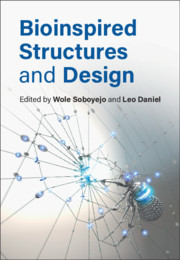Book contents
- Bioinspired Structures and Design
- Bioinspired Structures and Design
- Copyright page
- Contents
- Contributors
- Preface
- Part I Materials
- Part II Structures
- Part III Natural Phenomena
- 10 Aquatic Animals Operating at High Reynolds Numbers
- 11 Flying of Insects
- 12 Designing Nature-Inspired Liquid-Repellent Surfaces
- 13 Biomimetic and Soft Robotics
- 14 Bioinspired Building Envelopes
- Index
- References
14 - Bioinspired Building Envelopes
from Part III - Natural Phenomena
Published online by Cambridge University Press: 28 August 2020
- Bioinspired Structures and Design
- Bioinspired Structures and Design
- Copyright page
- Contents
- Contributors
- Preface
- Part I Materials
- Part II Structures
- Part III Natural Phenomena
- 10 Aquatic Animals Operating at High Reynolds Numbers
- 11 Flying of Insects
- 12 Designing Nature-Inspired Liquid-Repellent Surfaces
- 13 Biomimetic and Soft Robotics
- 14 Bioinspired Building Envelopes
- Index
- References
Summary
The history of architecture is laced with examples of bioinspiration, ranging from the use of decorative motifs to the implementation of functional and organizational principles found in plant and animal life. Likewise, a unique feature of our planet, one that allows life to flourish, has been named after a building type: The Greenhouse Effect. Exchanges in vocabulary from the fields of biology and construction occur quite frequently, i.e. building skin and cell wall, concrete shell and vault organelle, steel skeleton and body frame, and so on. As relative new sciences, it is no surprise that the fields of biology and earth sciences refer to things of scale and size more commonly understood, i.e. buildings. As they cope with the same environments and abide with the same physics, biology and architecture have developed similar solutions in their efforts to resist gravity’s pull or provide comfort and protection. The development of buildings is one of trial and error, a slow, evolutionary process that has to date produced very different building forms. Life, as well, is quite diverse in form and has arrived at this diversity using a limited palette of building materials and sources of energy. A seminal work on the development of form in biology is a book by D’Arcy W. Thompson, On Growth and Form, which first appeared in 1917 and has since become a landmark for biologist and bioinspired architects alike [1]. Using mathematical reasoning and physics, Thompson sets out to illustrate nature’s approach to derive shape, and illustrates how the forces at play are the same as those at play in the shaping of all matter, including buildings and bridges. An important tenet of his book concerns the importance of scale, how different physical forces work at different length-scales, and how these forces bring about vastly different results. It follows from his work that physics – the knowledge of nature – is essential to the understanding of biology and also forms a foundation for bioinspired design.
- Type
- Chapter
- Information
- Bioinspired Structures and Design , pp. 343 - 354Publisher: Cambridge University PressPrint publication year: 2020



